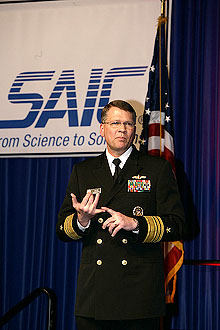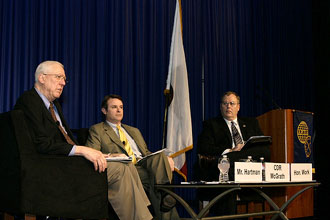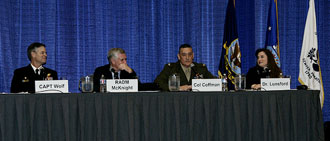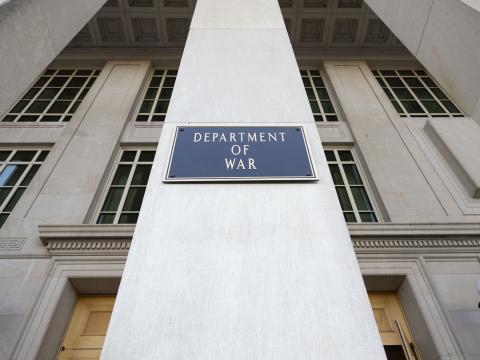West 2010 Online Show Daily: New Needs, New Missions Mandate a New Navy
The how may be more elusive than the funding for it.
 |
Vice Adm. David J. "Jack" Dorsett, USN, the Navy's first Deputy Chief of Naval Operations for Information Dominance (N2/N6), describes the rationale of the new construct during Day 2 of West 2010. |
The second day of West 2010 began with an examination of one of the Navy’s biggest recent changes. During the Wednesday luncheon, Vice Adm. David J. “Jack” Dorsett, USN, the first deputy chief of naval operations for information dominance (N2/N6), outlined the three issues that he sees as key in this newly created position. The U.S. Navy must determine what it means for the United States to have information dominance, how it plans to achieve it and what the opportunities are for industry in this regard.
To address these points, the Navy is nearly finished creating road maps for several areas in the information technology field. These road maps are being kept high and tight so that they are documents of action rather than documents collecting dust, the admiral stated. In addition, these plans will be shared with industry this year up to and including the classified level.
Adm. Dorsett related that the road map includes the principles that will be carried through plans for every sensor as well as how to network these sensors and how any shooter will be able to draw information and intelligence from the network. Sensors must not be stovepiped, the admiral stressed.
Under this general umbrella, road maps either have been or are being developed in several categories. These include undersea dominance; maritime intelligence, surveillance and reconnaissance; maritime ballistic C2; improved maritime domain awareness; unmanned systems; the Navy’s role in cyber offense and defense; fire control; integrated sensors; and C2 at the tip of the bow: strike. “This is a fundamental break from how this has been done before,” Adm. Dorsett said.
The admiral also emphasized that industry must be brought in earlier during the research, development and decision-making process. In this way, the Navy will benefit from knowing the available solutions, and industry will know where and how to spend its research and development resources. In fact, the service will share its road maps with industry partners at the classified level, first during a classified forum in June and again in September. During the first event, the Navy will discuss its requirements; during the second, industry is expected to come to the table with its ideas and solutions, he explained.
|
David Hartman (l) moderates the breakfast dialogue panel focusing on the future of the U.S. Navy with panelists (l-r) Cdr. Bryan McGrath, USN (Ret.), and Undersecretary of the Navy Robert O. Work. |
One answer was a modern navy, according to Cdr. Bryan McGrath, USN (Ret.), director of consulting, studies and analysis, Delex Systems, Inc. Cdr. McGrath noted that today’s Navy was designed in the Jimmy Carter administration to defeat the Soviet Union. The current U.S. Navy is flexible enough that it remains relevant, but emerging challenges will require a Navy that is capable of dealing with them.
And flexibility will be more important than numbers, according to Robert O. Work, undersecretary of the Navy. The Navy must maintain a persistent global presence, support counterinsurgency, support maritime security operations and must maximize the capability of every platform in the fleet, he declared. “We neither want nor need a regional navy,” he said, adding “we want a true global deployable navy.”
McGrath charged that the Navy is oversubscribed in land attack. “We don’t spend enough time and energy on what navies do: sea control,” he declared. He called for the development of a “navy-killing navy,” adding that a navy built around that capability would be able to conduct most of the other operations that could arise.
“Congress has a good record of giving us what we ask for,” McGrath added. “The problem is, are we asking for the right thing? Congress is cocked and loaded to give us more resources. We just have to ask them.”
|
Piracy panelists (l-r) Capt. Chuck Wolf, USN; Rear Adm. Terence E. McKnight, USN; Col. David W. Coffman, USMC; and Dr. Virginia Lunsford have a lively discussion about what is standing in the way of winning the war on piracy. |
In addition to Lundsford, panel members included Capt. Chuck Wolf, USN, commander, Naval Special Warfare Group 4; Rear Adm. Terence E. McKnight, USN, Expeditionary Strike Group 2, and commander, Task Force 51/59/151; and Col. David Coffman, USMC, commander, 13th Marine Expeditionary Unit. Although these experts agreed on the causes of piracy, they did not fully agree on what needs to be done to stop it. While Col. Coffman emphasized that his unit’s role is to defend U.S. interests with military force, Capt. Wolf offered that many piracy incidents can be resolved by solidifying national and international policies; displaying the will to defeat pirates; and deploying the equipment that offers non-kinetic solutions.
Even Adm. McKnight agreed that resolving piracy issues is a complicated and complex issue. One move by the U.S. Defense Department that has contributed to the complexity has been the creation of U.S. Africa Command. Although the command was created to bring some semblance to the issues in the area and solutions through African national cooperation, in fact it has created a chasm between the responsibilities that have belonged to U.S. Central Command large enough for pirates to sail right through.
Panelists and audience members brought up a number of other circumstances that have been contributing to the piracy fight. For example, should the United States be the leader in operations to defeat them when they are not threatening a U.S. vessel? Some said yes because it is the United States’ responsibility but also because of the nation’s interests in the area. Does the United States even have the authority to lead the war against piracy? While some of the panelists believe that this question has yet to be answered, others offered that U.N. resolutions give the United States the authority to go after pirates.






Comments